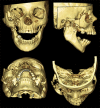Current Management of Zygomaticomaxillary Complex Fractures: A Multidisciplinary Survey and Literature Review
- PMID: 27833710
- PMCID: PMC5101115
- DOI: 10.1055/s-0036-1592093
Current Management of Zygomaticomaxillary Complex Fractures: A Multidisciplinary Survey and Literature Review
Abstract
Despite the prevalence of zygomaticomaxillary complex (ZMC) fractures, there is no consensus regarding the best approach to management. The aim of this study is to determine differences in ZMC fracture treatment among various surgical specialties. A survey was conducted regarding treatment of patients with different ZMC fractures that included a minimally displaced fracture (Case 1), a displaced fracture without diplopia (Case 2), a displaced fracture with diplopia (Case 3), and a complex comminuted fracture (Case 4). The survey was distributed to members of plastic surgery, oral maxillofacial surgery, and otolaryngology societies. The rates of surgical treatment, exploration of the orbital floor, and plating three or more buttresses were analyzed among the specialties. A total of 173 surgeons participated (46 plastic and reconstructive surgeons, 25 oral and maxillofacial surgeons, and 102 otolaryngologists). In Case 1, a significantly higher percentage of plastic surgeons recommend an operation (p < 0.01) compared with other specialties. More than 90% of surgeons would perform an operation on Case 2. Plastic surgeons explored the orbital floor (p < 0.01) and also fixated three or more buttresses more frequently (p < 0.01). More than 93% of surgeons would operate on Case 3, with plastic surgeons having the greatest proportion who fixed three or more buttresses (p < 0.01). In Case 4, there was no difference in treatment patterns between specialties. Across the specialties, more fixation was placed by surgeons with fewer years in practice (<10 years). Conclusion There is no consensus on standard treatment of ZMC fractures, as made evident by the survey. Significant variability in fracture type warrants an individualized approach to management. A thorough review on ZMC fracture management is provided.
Keywords: facial injuries; orbital fractures; zygomatic fractures.
Figures










Similar articles
-
Does Training Background Influence Decision-Making in the Management of Zygomaticomaxillary Complex Fractures?J Oral Maxillofac Surg. 2016 May;74(5):995-1012. doi: 10.1016/j.joms.2015.11.020. Epub 2015 Nov 24. J Oral Maxillofac Surg. 2016. PMID: 26706488
-
Clinical Criteria for Selective Exploration of Orbital Floor in Zygomaticomaxillary Complex Fractures.Craniomaxillofac Trauma Reconstr. 2020 Sep;13(3):180-185. doi: 10.1177/1943387520922035. Epub 2020 May 1. Craniomaxillofac Trauma Reconstr. 2020. PMID: 33456684 Free PMC article.
-
Isolated Orbital Floor Fracture Management: A Survey and Comparison of American Oculofacial and Facial Plastic Surgeon Preferences.Craniomaxillofac Trauma Reconstr. 2019 Jun;12(2):112-121. doi: 10.1055/s-0038-1639350. Epub 2018 Apr 9. Craniomaxillofac Trauma Reconstr. 2019. PMID: 31073360 Free PMC article.
-
Intraoperative imaging for the repair of zygomaticomaxillary complex fractures: a comprehensive review of the literature.J Craniomaxillofac Surg. 2014 Dec;42(8):1918-23. doi: 10.1016/j.jcms.2014.07.012. Epub 2014 Aug 13. J Craniomaxillofac Surg. 2014. PMID: 25213198 Review.
-
Management of fractures of the zygomaticomaxillary complex.Oral Maxillofac Surg Clin North Am. 2013 Nov;25(4):617-36. doi: 10.1016/j.coms.2013.07.011. Epub 2013 Sep 20. Oral Maxillofac Surg Clin North Am. 2013. PMID: 24055372 Review.
Cited by
-
Patterns of ZMC and Le Fort Fractures under the Impact of the COVID-19 Pandemic-"A Changing Face?".J Clin Med. 2024 Aug 8;13(16):4662. doi: 10.3390/jcm13164662. J Clin Med. 2024. PMID: 39200801 Free PMC article.
-
Zygomaticomaxillary Complex-Orbit Fracture Alignment: Comparison of Buccal and Orbital Approach Techniques.JAMA Facial Plast Surg. 2018 Sep 1;20(5):428-429. doi: 10.1001/jamafacial.2018.0411. JAMA Facial Plast Surg. 2018. PMID: 29799977 Free PMC article.
-
Automated 3D Analysis of Zygomaticomaxillary Fracture Rotation and Displacement.Plast Reconstr Surg Glob Open. 2021 Oct 25;9(10):e3888. doi: 10.1097/GOX.0000000000003888. eCollection 2021 Oct. Plast Reconstr Surg Glob Open. 2021. PMID: 34712545 Free PMC article.
-
Two-Point versus Three-Point Fixation in the Management of Zygomaticomaxillary Complex Fractures: A Comparative Study.Ann Maxillofac Surg. 2021 Jul-Dec;11(2):229-235. doi: 10.4103/ams.ams_75_20. Epub 2021 Dec 6. Ann Maxillofac Surg. 2021. PMID: 35265490 Free PMC article.
-
Evaluation of Efficacy of Different Plating Systems in ZMC Fractures: An Original Research.J Pharm Bioallied Sci. 2024 Feb;16(Suppl 1):S247-S249. doi: 10.4103/jpbs.jpbs_481_23. Epub 2024 Feb 29. J Pharm Bioallied Sci. 2024. PMID: 38595517 Free PMC article.
References
-
- Bogusiak K, Arkuszewski P. Characteristics and epidemiology of zygomaticomaxillary complex fractures. J Craniofac Surg. 2010;21(4):1018–1023. - PubMed
-
- Marinho R O, Freire-Maia B. Management of fractures of the zygomaticomaxillary complex. Oral Maxillofac Surg Clin North Am. 2013;25(4):617–636. - PubMed
-
- Ellis E III, el-Attar A, Moos K F. An analysis of 2,067 cases of zygomatico-orbital fracture. J Oral Maxillofac Surg. 1985;43(6):417–428. - PubMed
-
- Fonseca R J, Barber H D, Powers M P, Frost D E. Saint Louis, MO: Elsevier Health Sciences; 2013. Oral and Maxillofacial Trauma; pp. 354–450.
-
- Rowe N, Killey H. Baltimore, MD: Williams & Wilkins; 1955. Fractures of the Facial Skeleton; pp. 205–451.
Grants and funding
LinkOut - more resources
Full Text Sources
Other Literature Sources
